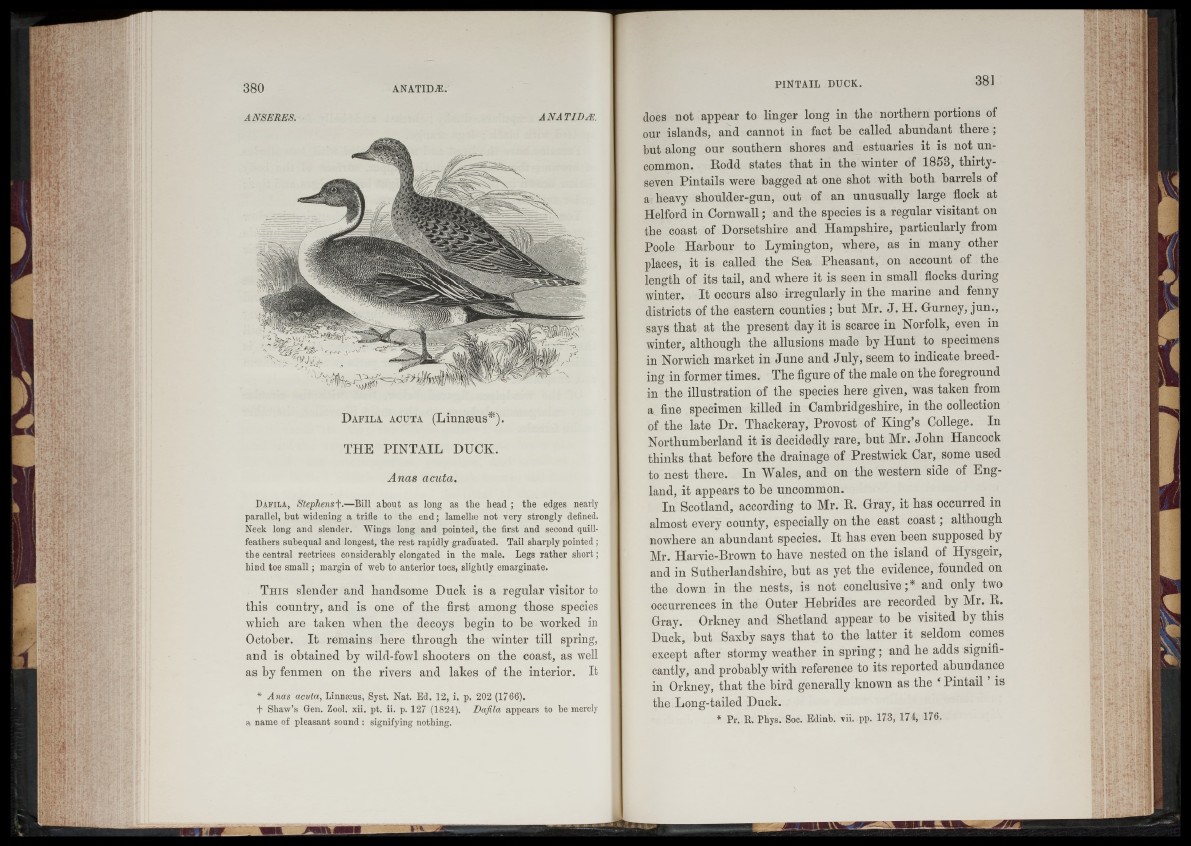
A NSERES. A NA TIDÆ.
D a f i l a a c u t a (Linnæus*).
THE PINTAIL DUCK.
Anas acuta.
Dafila, Stephens f.—Bill ab o u t as long as th e head ; th e edges nearly
p ara llel, b u t widening a trifle to th e e n d ; lamellte n ot -very strongly defined.
Neck long an d slender. Wings long an d p o in ted , th e first an d second quill-
fea th ers subequal an d longest, th e re s t rap id ly g rad u a ted . Tail sh a rp ly pointed ;
th e cen tral rectrices considerably elongated in th e male. Legs r a th e r s h o r t;
h in d toe sm a l l ; marg in of web to a n te rio r toes, slightly emarginate.
T h i s slender and handsome Duck is a regular visitor to
this country, and is one of the first among those species
which are taken when the decoys begin to be worked in
October. It remains here through the winter till spring,
and is obtained by wild-fowl shooters on the coast, as well
as by fenmen on the rivers and lakes of the interior. It
* Anas acuta, Linnarus, Syst. Nat. Ed. 12, i. p. 202 (1766).
1* Shaw’s Gen. Zool. x ii. p t. ii. p. 127 (1824). Dafila ap p e ars to be merely
a name of p le asan t sound : signifying nothing.
does not appear to linger long in the northern portions of
our islands, and cannot in fact be called abundant there ;
but along our southern shores and estuaries it is not uncommon.
Rodd states that in the winter of 1853, thirty-
seven Pintails were bagged at one shot with both barrels of
a heavy shoulder-gun, out of an unusually large flock at
Helford in Cornwall; and the species is a regular visitant on
the coast of Dorsetshire and Hampshire, particularly from
Poole Harbour to Lymington, where, as in many other
places, it is called the Sea Pheasant, on account of the
length of its tail, and where it is seen in small flocks during
winter. It occurs also irregularly in the marine and fenny
districts of the eastern counties ; hut Mr. J. H. Gurney, jun.,
says that at the present day it is scarce in Norfolk, even in
winter, although the allusions made by Hunt to specimens
in Norwich market in June and July, seem to indicate breeding
in former times. The figure of the male on the foreground
in the illustration of the species here given, was taken from
a fine specimen killed in Cambridgeshire, in the collection
of the late Dr. Thackeray, Provost of King’s College. In
Northumberland it is decidedly rare, hut Mr. John Hancock
thinks that before the drainage of Prestwick Car, some used
to nest there. In Wales, and on the western side of England,
it appears to be uncommon.
In Scotland, according to Mr. R. Gray, it has occurred in
almost every county, especially on the east coast; although
nowhere an abundant species. It has even been supposed by
Mr. Harvie-Brown to have nested on the island of Hysgeir,
and in Sutherlandshire, but as yet the evidence, founded on
the down in the nests, is not conclusive;* and only two
occurrences in the Outer Hebrides are recorded by Mi. R.
Gray. Orkney and Shetland appear to be visited by this
Duck, hut Saxby says that to the latter it seldom comes
except after stormy weather in spring; and he adds significantly,
and probably with reference to its reported abundance
in Orkney, that the bird generally known as the ‘ Pintail ’ is
the Long-tailed Duck.
* P r. R. P hys. Soc. Edinb. vii. pp. 173, 174, 176.